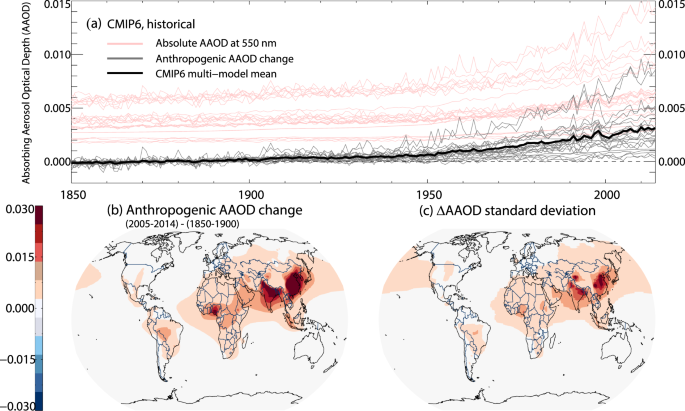
- Select a language for the TTS:
- UK English Female
- UK English Male
- US English Female
- US English Male
- Australian Female
- Australian Male
- Language selected: (auto detect) - EN
Play all audios:
ABSTRACT Precipitation change has proven notoriously hard to simulate consistently between global climate models. Aerosol induced shortwave absorption over the historical era is also poorly
constrained in both observations and modelling. These factors are closely linked, since absorption induced heating of the atmospheric column inhibits precipitation formation. Here I show
that the spread in simulated aerosol absorption in the most recent generation of climate models (CMIP6) can be a dominating cause of uncertainty in simulated precipitation change, globally
and regionally. Consequently, until improvements are made in scientific understanding of the key absorbing aerosol types, projections of precipitation change under future anthropogenic
emissions will have major, irreducible uncertainties. Black carbon, which has recently been found to have only a weak influence on global surface temperature, regains prominence as a
contributor to regional precipitation change and its historical and future evolution. SIMILAR CONTENT BEING VIEWED BY OTHERS STRONG CONTROL OF EFFECTIVE RADIATIVE FORCING BY THE SPATIAL
PATTERN OF ABSORBING AEROSOL Article Open access 21 July 2022 MULTIFACETED AEROSOL EFFECTS ON PRECIPITATION Article 09 August 2024 BIOMASS BURNING AEROSOLS IN MOST CLIMATE MODELS ARE TOO
ABSORBING Article Open access 12 January 2021 INTRODUCTION Anthropogenic influences have caused a net increase in global mean surface temperature by 1.1 °C over the historical era1,2, along
with a wide range of other aspects of climate change that include, notably, mean and extreme precipitation3. However, while the observed magnitude and regional pattern of global surface
warming are well reproduced by the most recent generation of global climate models4,5, historical precipitation change has proven more challenging to simulate6,7,8, which in turn reduces
confidence in projections of hydroclimate-related future hazards9,10. It is well recognized that this uncertainty is partly due to the high complexity of the geophysical processes involved8,
which include clouds11, evaporation12, and the atmospheric energy balance13, and partly because observations of precipitation are more uncertain, sparse, and of shorter duration than for
surface temperature, which makes model validation more challenging8. Another, less appreciated, cause of model diversity in simulated precipitation change is the sensitivity to changes in
atmospheric aerosols14,15, which is still a major source of uncertainty in global climate models16. This influence has two main components17. One is the reduction in average precipitation
that follows from the net cooling influence of aerosols on global mean surface temperature (sometimes termed “slow precipitation change”). The other mechanism, which is much more
scientifically uncertain, is the rapid adjustment of the atmospheric column to the presence of aerosol-induced atmospheric heating15,18. This process inhibits precipitation formation, as the
release of latent heat due to condensation has to compete with the warming rate absorbing aerosols. Cloud formation is also affected18, due both to warming-induced changes in lapse rate and
to droplet evaporation if an absorbing aerosol is present within a cloud. Previous studies have established a robust, linear relationship between atmospheric absorption and precipitation
inhibition, in a wide range of recent climate models, both on global mean14,19 and for regional changes in aerosol emissions20,21. This relationship is well understood in terms of the
influence of aerosols on the local energy balance15,22,23. The amount of aerosol-induced shortwave energy absorption in the present atmosphere, and, consequently, in simulations of
historical climate change in Earth System Models, is however highly uncertain24,25,26. The primary reason for this is that aerosol-induced absorption is, as yet, virtually unconstrained by
observations24. Most current photometric satellite sensors do not have the capability to measure absorption. It can be retrieved through an inversion of measurements from sun-sky photometers
at Aerosol Robotic Network (AERONET) stations27,28, albeit with notable uncertainties, sparse geographical coverage, and limitations on capabilities in low aerosol loading conditions29,30.
Model estimates, on the other hand, suffer from temporal and spatial uncertainties in aerosol emission inventories, limited knowledge of aerosol optical properties, transport, wet removal,
ageing, atmospheric chemistry, aerosol-cloud interactions and deposition rates24. Moreover, even though there have been marked improvements over the 5th and 6th phases of the Coupled Model
Intercomparison Project (CMIP5, CMIP6), the treatment of aerosols in many global climate models is still simplified, partly for reasons of computational efficiency, partly because physical
processes such as internal aerosol mixing and ageing are not always implemented25. It is therefore prudent to ask what the influence of poorly constrained aerosol absorption is on scientific
knowledge of historical precipitation change. The main absorbing aerosol species is black carbon (BC), a byproduct of incomplete combustion, that has long been studied as a contributor to
global warming31. While this influence was assessed in the IPCC 6th Assessment Report to be only ~0.1 °C over the historical era32, the potential influence of BC-induced absorption on
precipitation inhibition has been much less studied. BC was recently found to constitute around 60% of the total aerosol absorption in current models25. The remainder comes from the
absorbing component of organic carbon (brown carbon, or BrC; 11%), and from dust (31%). BC, BrC and dust atmospheric loadings have all changed over the historical era, either from
anthropogenic emissions or as feedbacks to global surface temperature and land use changes. The inter-model uncertainties on this set of processes are however very high, leading to a
potentially quite marked propagated uncertainty on modelled precipitation. In the following, simulations from a range of recent single model and multi-model intercomparison studies are used
to quantify the current model diversity in aerosol absorption, and how it has changed over the historical era. A relation is then established that can be used to propagate this diversity to
a contribution to global and regional uncertainty in modelled precipitation, via rapid adjustments. The main conclusion is that aerosol absorption may make up a dominating source of current
inter-model differences, and that this uncertainty is irreducible until improvements are made to treatments of absorbing aerosols in global models, and tighter observational constraints
become available. Currently, aerosol-induced shortwave absorption constitutes a limiting factor for the capability of the climate modelling community to project and communicate near-term
climate hazards related to precipitation change. RESULTS AEROSOL ABSORPTION UNCERTAINTY IN CMIP6 The starting point for this analysis is the inter-model spread in aerosol-induced shortwave
absorption in CMIP6, over the historical era. Aerosol absorption is commonly quantified in two ways. One is through absorbing aerosol optical depth (AAOD), a quantity that is retrievable
(albeit not directly measurable) from observations30. Broadly, AAOD is the integrated extinction of shortwave energy by aerosols through the atmospheric column attributable to absorbing
aerosols, and a component of the more commonly used total Aerosol Optical Depth (AOD). AAOD is retrievable from observations and is therefore often used for model validation, even though its
magnitude is not presently well constrained24. The second method for quantifying absorption is as the difference between top-of-atmosphere and surface radiative forcing, in Wm−2. This can
be done exclusively in shortwave radiation, in long wave, or as their net. While this second measure is more directly relatable to the physical effects of aerosols on the climate, and thus
more useful for quantifying precipitation change, it is only available from climate models. The following analysis uses both quantities, and also documents and exploits their close relation.
Figure 1 shows the historical evolution and inter-model diversity in aerosol-induced absorption in CMIP6, in terms of AAOD at 550 nm. Already in the 1850–1900 period, the simulated absolute
global, annual mean AAOD varies between 0.002 and 0.006. This is related to differences in amount and treatment of natural aerosols in the models (mainly dust and biomass burning), and to
differences in aerosol optical properties and distribution. Subtracting the 1850–1900 value from each model leaves the change over the historical era, which can be attributed to
anthropogenic emissions, land use change, or feedbacks from surface temperature change to the extent that they are captured in CMIP6 models. In the following, this is termed “anthropogenic
AAOD”. While all models exhibit a clear increase up to 2014 (the last year of the CMIP6 historical simulations), related primarily to aerosol emission inventories common to all the
models33,34, simulated anthropogenic AAOD in 2014 varies from 0.001 to 0.009. The multi-model mean anthropogenic AAOD is 0.003, with a standard deviation of 100% relative to the mean
(0.003). For comparison, Sand et al. recently reported a multi-model mean total, present day AAOD at 550 nm of 0.0054 [0.0030, 0.0098] from the AeroCom Phase III exercise25, which is
consistent with the mean and spread of the CMIP6 results presented here. Atmospheric aerosol loading is, however, highly spatially heterogeneous. Precipitation inhibition will initially
occur where the absorbing aerosols are located (which generally differs from where they are emitted, depending on prevailing wind and precipitation patterns), but changes can also be induced
remotely depending on teleconnections from the region of absorption35,36,37. Figure 1 also shows the geographical distribution of AAOD change, for the period 2005–2014 relative to
1850–1900. The pattern is dominated by the current regions of high BC emissions, notably South and East Asia, and their downwind regions. The biomass-burning regions of Africa and South
America are also visible. Finally, panel c shows the CMIP6 inter-model standard deviation, on the same scale. For key, highly populated regions in India and China, the standard deviation is
comparable in magnitude to the absorption itself, underscoring the low level of scientific understanding that still exists for this climate-relevant quantity. Again, CMIP6 results are
consistent with AeroCom Phase III (ref. 25, their Fig. 2). RELATING ABSORBING OPTICAL DEPTH TO PRECIPITATION INHIBITION The next step is to quantify the emergent relation between aerosol
absorption and precipitation inhibition, using a linear expansion: $$\triangle P=\,\frac{{dP}}{{d{{{{\rm{Abs}}}}}}}\times \frac{{d{{{{\rm{Abs}}}}}}}{{d{{{{\rm{AAOD}}}}}}}\,\triangle
{{{{{\rm{AAOD}}}}}}$$ (1) here Abs denotes atmospheric absorption (in Wm−2), and _P_ is precipitation (in mm year−1). The two terms of Eq. 1 have been separately investigated in, or can be
quantified from, recent multi-model intercomparison projects (MIPs) and publications. These results are synthesized in Fig. 2. ΔAbs/ΔAAOD was first investigated in Phase II of the AeroCom
exercise26. Here, aerosol models, primarily running with fixed meteorology, quantified the radiative impacts of all present-day anthropogenic aerosols relative to preindustrial conditions.
Their multi-model median result, ΔAbs/ΔAAOD = 479 ± 165 Wm−2/(unit AAOD), shows marked inter-model diversity, but still a clear correlation between the two quantities. CMIP6 has no directly
comparable experiments. However, a comparable result can be extracted from the ScenarioMIP historical simulation, by quantifying the shortwave absorption (change in top-of-atmosphere
shortwave flux minus the change in surface flux), and accounting for the simultaneous change in methane concentration. See Methods. The results are shown in Fig. 2a, overlain with AeroCom
Phase II. Results from the two MIPs have correlation coefficients that are consistent within the estimated uncertainties. The relation between precipitation inhibition due to rapid
adjustments, and atmospheric absorption, was first quantified in Andrews et al.19, using idealized perturbations to single climate forcers (CO2, CH4, BC, SO4, insolation) in a single climate
model. Similar experiments were later performed in a multi-model setting by PDRMIP14,17. Their results are shown in Fig. 2b, with a ratio of ΔP/ΔAbs = −9.7 ± 0.1 mm year−1/W m−2. However,
as the PDRMIP experiments were primarily global perturbations, a question remains about whether this global relation holds for all regions. No dataset yet exists that can fully answer this,
but PDRMIP did include one regional experiment with absorbing aerosols, increasing BC over Asia, which yields results in line with the above relation20. Also, this question was recently
further addressed in Persad21, who performed simulations using a single model, altering BC concentrations in a number of selected regions in all continents except Antarctica. Their results
are overlain with PDRMIP in Fig. 2b. While the perturbations in the regional experiments are weaker in magnitude and will have a lower spread because they are performed in a single model, it
is still worth noting that they follow a comparable correlation, within the multi-model uncertainty, as that quantified from PDRMIP. The relations in Fig. 2a, b, and their uncertainties,
can be combined using Eq. 1 into the joint relation between AAOD and precipitation inhibition shown in Fig. 2c. Numerically, the relation is ΔP/ΔAAOD = −4646 ± 1600 mm year−1/(unit AAOD),
where the uncertainty (relative standard deviation (RSD) of 34%) is dominated by the model diversity in the relation between AAOD and atmospheric absorption (RSD of 31%; Fig. 2a). The reason
that this assumption can be made, is that while the aerosol treatment of the models included in the various studies (AeroCom, PDRMIP and others) differ markedly, they are all of sufficient
complexity to include the atmospheric heating rates resulting from the presence of a SW absorbing agent. Hence, differences in the aerosol assumptions will initially contribute to the spread
in AAOD, as discussed above, and any further differences in response will be captured by the uncertainties of the two relations. DIAGNOSED PRECIPITATION INHIBITION Having quantified the
uncertainty in AAOD in CMIP6, globally and regionally, and found a relation between AAOD and precipitation inhibition that can be assumed to be valid for the historically major anthropogenic
aerosol emission regions, we can estimate the influence of anthropogenic aerosol absorption on historical precipitation change. Figure 3a shows the diagnosed precipitation inhibition from
rapid adjustments for 28 CMIP6 models (or ensemble members; see Supplementary Methods). The multi-model, global, annual mean precipitation inhibition in 2014 is −15 mm year−1, with an
inter-model spread (5–95%) of −2 – −40 mm year−1. Assuming global validity of Eq. 1 (while noting that this assumption will require further work to fully substantiate) allows calculation of
the regional distribution of precipitation inhibition. Figure 3b shows the regions of maximum influence, where the annual mean influence of absorption reaches −200 mm year−1, or up to 25% of
the regional total (Fig. 3c). Similar to the result for AAOD, the inter-model spread is very high, with a standard deviation numerically similar to the inhibition itself (Fig. 3d). AEROSOL
ABSORPTION INFLUENCE ON HISTORICAL PRECIPITATION CHANGE Finally, the absorption-induced precipitation inhibition and its uncertainty in CMIP6 can be put in the context of historical
precipitation change. Figure 4 shows results from the Detection and Attribution Model Intercomparison Project (DAMIP)38, for surface temperature (4a), and for precipitation (4b). As has been
shown in a number of studies3,4,39, the observed net change in global mean surface temperature attributable to GHG-induced warming and aerosol-induced cooling, closely tracks both
observations and the CMIP6 mean simulated historical evolution. For global annual mean precipitation, the corresponding net change is weak (~5 mm year−1), and there is near balance between
GHG and aerosol influences, reflecting the stronger hydrological sensitivity of the global climate to aerosol changes (3.7%/°C) relative to greenhouse gases (1.7%/°C); a difference that is
mainly attributable to differences in absorption15,40. See Methods. While the global means used here do not reflect underlying geographical shifts in precipitation, this near-balance does
indicate a high sensitivity of the total precipitation change to both aerosols and greenhouse gases as they are presently treated in global climate models. For comparison, the CMIP6
inter-model spread in precipitation inhibition due to uncertainty in aerosol absorption, calculated from the analysis above, is around 35 mm year−1 (5–95% range, Fig. 4b). Note that this
uncertainty is markedly larger than the inter-model spread in historical precipitation change simulated by CMIP6 models (±5 mm year−1), and around four times higher than the absolute change
over the historical era simulated by both ScenarioMIP and DAMIP. This apparent contradiction indicates that there are compensating processes, and likely some degree of tuning, in
precipitation responses in current models, and further indicates a potentially high sensitivity of precipitation to future changes in aerosol absorption. DISCUSSION The above analysis
documents how precipitation inhibition from aerosol-induced absorption can be a key factor in simulating both global and regional hydroclimate. Together with the weak constraints that can
currently be placed on global AAOD, and its historical evolution, this implies that aerosol-induced absorption is a key—and possibly dominating—uncertainty factor in our understanding of
historical precipitation change. This is particularly important given the ongoing and expected future rapid changes in aerosol emissions in several regions, including the current hotspots in
South and East Asia. Among aerosol species, the key absorbing anthropogenic emission type is BC. While the IPCC recently assessed the global mean temperature impact of present-day BC
emissions to be relatively weak (~0.1 °C), the results described here indicate that BC may have a much more important role in anthropogenic precipitation change. Should BC emissions be
markedly reduced over the coming decades, as happens e.g. in Shared Socioeconomic Pathways assuming stringent air quality (SSP1)41,42, this may unmask currently inhibited mean and extreme
precipitation in populated regions, including India, China and North America, as has been indicated in recent model-based literature43,44,45,46,47. Future changes in BrC and dust emissions
are also of importance, notably as they affect different regions to BC, and also as potential feedback from GHG-induced surface temperature change and industrial activities. Reasons for the
diversity in simulated aerosol absorption in CMIP6 models include uncertainties in emission inventories, differences in the complexity of the modelled aerosol-climate interactions, and
various poorly constrained quantities and processes such as optical properties, transport, growth, ageing and wet removal of particles, aerosol-cloud interactions, and more. It is, however,
worth noting that the precipitation inhibition discussed above is independent of the details of aerosol emission and transport, as it occurs primarily through the influence of shortwave
heating aloft on precipitation formation. This process is well represented in all modern Earth System Models, so it is reasonable to expect that the uncertainty in aerosol absorption
translates directly into precipitation uncertainty. Regional rapid responses to absorbing aerosols are likely to be highly heterogenous and seasonally dependent, notably near complex
dynamical phenomena such as monsoons. It is unlikely, however, that this heterogeneity will act to reduce the inter-model diversity in aerosol-precipitation modelling. Robust projections of
global and regional precipitation change, in response to the wide range of possible future greenhouse gas and aerosol emissions and the associated global warming, remains both a challenge
for the scientific community and an important topic at the science-policy interface. The results shown here indicate a need for heightened focus on constraining the emissions and atmospheric
distributions of atmospheric aerosols, notably black carbon, organic carbon and dust. While this has long been recognized as a tough challenge, rapid progress is possible with joint effort
from the observational and modelling communities24. Notably, there is a need for systematic aircraft measurements, improved capabilities for both ground and satellite-based retrieval
systems, and for inclusion and uptake of any improved constraints in global climate models. The latter requires further development and validation of aerosol processes in Earth System
Models, and also reduced biases in the modelled regional and seasonal cloud and precipitation climatologies. In addition, further analyses and sensitivity experiments are required in order
to understand the influence of aerosol-induced absorption on current CMIP6 based projections of mean and extreme precipitation under future emissions and global warming—and their strong
impacts on nature and society. METHODS MODEL SIMULATIONS USED For a full list of models and experiments, see the Supplementary Methods. ScenarioMIP48: Simulated climate evolution over the
historical era (1850–2014) is from ScenarioMIP, part of the CMIP6 exercise. Participating global climate models used the same emissions of greenhouse gases and aerosols, other forcings such
as land use, as well as natural forcings such as insolation and volcanoes. The present analysis uses monthly mean output of near-surface (2 m) temperature, precipitation, shortwave radiative
fluxes at top-of-atmosphere and surface level, and column-integrated absorbing aerosol optical depth. DAMIP38: Detection and Attribution MIP (DAMIP) performed model experiments where only
anthropogenic well-mixed greenhouse gas (hist-GHG) or aerosol (hist-aer) emissions were allowed to vary over the period 1850–2020, leaving all other emissions and natural forcings at 1850
levels. For the period 2015–2020, the emissions followed the SSP2-4.5 pathway. The present analysis uses monthly mean output of near-surface (2 m) temperature and precipitation. Additional
values used for Fig. 3 were extracted directly from the cited literature. DIAGNOSING SHORTWAVE ABSORPTION IN CMIP6 The following procedure was used to estimate the shortwave (SW) atmospheric
absorption ascribable to anthropogenic aerosols in CMIP6 historical simulations (Fig. 2a). For each model, the change in net SW flux (_F_SW) was calculated over the historical era
(1995–2014 relative to 1850–1900) at top-of-atmosphere (TOA) and surface (SURF). The total change in shortwave absorption (AbsSW) is then
$${{{{{{\rm{Abs}}}}}}}_{{{{{{\rm{SW}}}}}}}^{{{{{{\rm{Total}}}}}}}\,=\,{\triangle F}_{{{{{{\rm{SW}}}}}}}^{{{{{{\rm{TOA}}}}}}}-{\triangle F}_{{{{{{\rm{SW}}}}}}}^{{{{{{\rm{SURF}}}}}}}$$ (2)
here, all radiation fields are all-sky (i.e. combining cloudy and cloud-free conditions). However, aerosols are not the only atmospheric component with shortwave absorption to change over
the historical era. Notably, changes in methane concentration will influence the results of Eq. 2. Recently, Collins et al.49 estimated a methane-induced SW absorption increase of 0.68 Wm−2
over a period comparable to the one used here for CMIP6. We subtracted this to arrive at an estimate for the aerosol-induced absorption:
$${{{{{{\rm{Abs}}}}}}}_{{{{{{\rm{SW}}}}}}}^{{{{{{\rm{Aero}}}}}}}\,=\,{{{{{{\rm{Abs}}}}}}}_{{{{{{\rm{SW}}}}}}}^{{{{{{\rm{Total}}}}}}}-{{{{{{\rm{Abs}}}}}}}_{{{{{{\rm{SW}}}}}}}^{{{{{{\rm{CH}}}}}}4}$$
(3) This is clearly a simplified estimate, and consequently, it has not been included in the final quantification following Eq. 1. However, if the CMIP6 are included in the regression in
addition to AeroCom Phase II, the correlation coefficient remains the same within the stated errors. For an overview of historical anthropogenic SW aerosol absorption quantified from CMIP6
models, see Supplementary Table 1. HYDROLOGICAL SENSITIVITY The hydrological sensitivity in DAMIP, or precipitation change per degree Celsius of global mean surface temperature change, is
calculated based on the multi-model mean total change in 2001–2020 relative to 1850–1900. This quantity is what is elsewhere termed the “apparent hydrological sensitivity” and is different
to the “slow hydrological sensitivity” which is the response to surface temperature change in the absence of rapid adjustments50. DATA AVAILABILITY All simulations used for the present
manuscript are publicly available through open data access portals. CMIP6 results are available through the Earth System Grid Federation (ESGF). PDRMIP simulations are available from the
Norwegian storage service NIRD (https://cicero.oslo.no/en/PDRMIP/PDRMIP-data-access). AeroCom simulations are available through aerocom.met.no. CODE AVAILABILITY All analyses were performed
using the software packages IDL (version 8.3) and cdo (version 1.9.8). No custom code was used. Plotting scripts for all figures are available upon request to the corresponding author.
REFERENCES * IPCC. Summary for Policymakers. In: Climate Change 2021: The Physical Science Basis. Contribution of Working Group I to the Sixth Assessment Report of the Intergovernmental
Panel on Climate Change (eds Masson-Delmotte, V. et al.]. (Cambridge University Press, Cambridge, United Kingdom and New York, NY, USA, 2021). * Gulev, S. K. et al. In _Climate Change 2021:
The Physical Science Basis. Contribution of Working Group I to the Sixth Assessment Report of the Intergovernmental Panel on Climate Change_ (eds Masson-Delmotte, V. et al.) 287–422
(Cambridge University Press, 2021). * Eyring, et al. Human Influence on the Climate System. In Climate Change 2021: The Physical Science Basis. Contribution of Working Group I to the Sixth
Assessment Report of the Intergovernmental Panel on Climate Change (eds Masson-Delmotte, V. et al.). Cambridge University Press, Cambridge, United Kingdom and New York, NY, USA, pp. 423–552
https://doi.org/10.1017/9781009157896.005 (2021). * Tokarska, K. B. et al. Past warming trend constrains future warming in CMIP6 models. _Sci. Adv._ 6, eaaz9549 (2020). * Liang, Y., Gillett,
N. P. & Monahan, A. H. Climate model projections of 21st century global warming constrained using the observed warming trend. _Geophys. Res. Lett._ 47,
https://doi.org/10.1029/2019gl086757 (2020). * Li, J., Huo, R., Chen, H., Zhao, Y. & Zhao, T. Comparative assessment and future prediction using CMIP6 and CMIP5 for annual precipitation
and extreme precipitation simulation. _Front. Earth Sci._ 9, https://doi.org/10.3389/feart.2021.687976 (2021). * Stephens, G. L. et al. Dreary state of precipitation in global models. _J.
Geophys. Res.: Atmos._ 115, https://doi.org/10.1029/2010jd014532 (2010). * Douville, H. et al. In _Climate Change 2021: The Physical Science Basis. Contribution of Working Group I to the
Sixth Assessment Report of the Intergovernmental Panel on Climate Change_ (eds V. Masson-Delmotte. et al.) 1055–1210 (Cambridge University Press, 2021). * John, A., Douville, H., Ribes, A.
& Yiou, P. Quantifying CMIP6 model uncertainties in extreme precipitation projections. _Weather Clim. Extrem._ 36, https://doi.org/10.1016/j.wace.2022.100435 (2022). * Seneviratne, S. I.
et al. In _Climate Change 2021: The Physical Science Basis. Contribution of Working Group I to the Sixth Assessment Report of the Intergovernmental Panel on Climate Change_ (eds V.
Masson-Delmotte. et al.) 1513–1766 (Cambridge University Press, 2021). * Tselioudis, G. et al. Evaluation of clouds, radiation, and precipitation in cmip6 models using global weather states
derived from Isccp-H cloud property data. _J. Clim._ 1–42, https://doi.org/10.1175/jcli-d-21-0076.1 (2021). * Myhre, G. et al. Sensible heat has significantly affected the global
hydrological cycle over the historical period. _Nat. Commun._ 9, 1922 (2018). Article CAS Google Scholar * Richardson, T. et al. Drivers of precipitation change: an energetic
understanding. _J. Clim._ 31, 9641–9657 (2017). * Samset, B. H. et al. Fast and slow precipitation responses to individual climate forcers: a PDRMIP multimodel study. _Geophys. Res. Lett._
43, 2782–2791 (2016). Article Google Scholar * Myhre, G. et al. Quantifying the importance of rapid adjustments for global precipitation changes. _Geophys. Res. Lett._ 45, 11399–11405
(2018). Article CAS Google Scholar * Szopa, S. et al. In _Climate Change 2021: The Physical Science Basis. Contribution of Working Group I to the Sixth Assessment Report of the
Intergovernmental Panel on Climate Change_ (eds Masson-Delmotte, V. et al.) 817–922 (Cambridge University Press, 2021). * Myhre, G. et al. PDRMIP: A Precipitation Driver and Response Model
Intercomparison Project—Protocol and Preliminary Results. _Bull. Am. Meteorol. Soc._ 98, 1185–1198 (2017). Article CAS Google Scholar * Sand, M., Samset, B. H., Tsigaridis, K., Bauer, S.
E. & Myhre, G. Black carbon and precipitation: an energetics perspective. _J. Geophys. Res.: Atmos._ 125, e2019JD032239 (2020). * Andrews, T., Forster, P. M., Boucher, O., Bellouin, N.
& Jones, A. Precipitation, radiative forcing and global temperature change. _Geophys. Res. Lett._ 37, https://doi.org/10.1029/2010gl043991 (2010). * Liu, L. et al. A PDRMIP multimodel
study on the impacts of regional aerosol forcings on global and regional precipitation. _J. Clim._ 31, 4429–4447 (2018). Article CAS Google Scholar * Persad, G. The dependence of
aerosols’ global and local precipitation impacts on emitting region. _Atmos. Chem. Phys. Discuss_. https://doi.org/10.5194/acp-2022-97 (2022). * O’Gorman, P., Allan, R., Byrne, M. &
Previdi, M. Energetic constraints on precipitation under climate change. _Surveys Geophys._ 33, 585–608 (2012). Article Google Scholar * Pendergrass, A. G. & Hartmann, D. L. The
atmospheric energy constraint on global-mean precipitation change. _J. Clim._ 27, 757–768 (2013). Article Google Scholar * Samset, B. H. et al. Aerosol absorption: progress towards global
and regional constraints. _Curr. Clim. Change Rep._ 4, 65–83 (2018). Article Google Scholar * Sand, M. et al. Aerosol absorption in global models from AeroCom Phase III. _Atmos. Chem.
Phys_. https://doi.org/10.5194/acp-2021-51 (2021). * Myhre, G. et al. Radiative forcing of the direct aerosol effect from AeroCom Phase II simulations. _Atmos. Chem. Phys._ 13, 1–25 (2013).
Article Google Scholar * Kayetha, V., Torres, O. & Jethva, H. Retrieval of UV–visible aerosol absorption using AERONET and OMI–MODIS synergy: spatial and temporal variability across
major aerosol environments. _Atmos. Meas. Tech._ 15, 845–877 (2022). Article CAS Google Scholar * Giles, D. M. et al. An analysis of AERONET aerosol absorption properties and
classifications representative of aerosol source regions. _J. Geophys. Res.: Atmos._ 117, n/a–n/a (2012). Article Google Scholar * Andrews, E., Ogren, J. A., Kinne, S. & Samset, B.
Comparison of AOD, AAOD and column single scattering albedo from AERONET retrievals and in situ profiling measurements. _Atmos. Chem. Phys._ 17, 6041–6072 (2017). Article CAS Google
Scholar * Schutgens, N. et al. AEROCOM and AEROSAT AAOD and SSA study – Part 1: Evaluation and intercomparison of satellite measurements. _Atmos. Chem. Phys._ 21, 6895–6917 (2021). Article
CAS Google Scholar * Bond, T. C. et al. Bounding the role of black carbon in the climate system: a scientific assessment. _J. Geophys. Res.: Atmos._ 118, 5380–5552 (2013). Article CAS
Google Scholar * Forster, P. et al. In _Climate Change 2021: The Physical Science Basis. Contribution of Working Group I to the Sixth Assessment Report of the Intergovernmental Panel on
Climate Change_ (eds Masson-Delmotte, V. et al.) 923–1054 (Cambridge University Press, 2021). * Hoesly, R. M. et al. Historical (1750–2014) anthropogenic emissions of reactive gases and
aerosols from the Community Emissions Data System (CEDS). _Geosci. Model Dev_. 11, 369–408 (2018). . * Lund, M. T. et al. A continued role of short-lived climate forcers under the shared
socioeconomic pathways. _Earth Syst. Dynam. Discuss_. https://doi.org/10.5194/esd-2020-9 (2020). * Dagan, G., Stier, P. & Watson‐Parris, D. An energetic view on the geographical
dependence of the fast aerosol radiative effects on precipitation. _J. Geophys. Res.: Atmos._ 126, https://doi.org/10.1029/2020jd033045 (2021). * Chemke, R. & Dagan, G. The effects of
the spatial distribution of direct anthropogenic aerosols radiative forcing on atmospheric circulation. _J. Clim._ 31, 7129–7145 (2018). Article Google Scholar * Wei, L. et al. Black
carbon-climate interactions regulate dust burdens over India revealed during COVID-19. _Nat. Commun._ 13, 1839 (2022). Article CAS Google Scholar * Gillett, N. P. et al. The Detection and
Attribution Model Intercomparison Project (DAMIP v1.0) contribution to CMIP6. _Geosci. Model Dev._ 9, 3685–3697 (2016). Article Google Scholar * Aizawa, T., Oshima, N. & Yukimoto, S.
Contributions of anthropogenic aerosol forcing and multidecadal internal variability to mid‐20th century Arctic cooling—CMIP6/DAMIP multimodel analysis. _Geophys. Res. Lett._ 49,
https://doi.org/10.1029/2021gl097093 (2022). * Samset, B. H. et al. Weak hydrological sensitivity to temperature change over land, independent of climate forcing. _npj Clim. Atmos. Sci._ 1,
https://doi.org/10.1038/s41612-017-0005-5 (2018). * Rao, S. et al. Future air pollution in the shared socio-economic pathways. _Glob. Environ. Change_ 42, 346–358 (2017). Article Google
Scholar * Lund, M. T., Myhre, G. & Samset, B. H. Anthropogenic aerosol forcing under the shared socioeconomic pathways. _Atmos. Chem. Phys._ 19, 13827–13839 (2019). Article CAS Google
Scholar * Samset, B. H. et al. Climate impacts from a removal of anthropogenic aerosol emissions. _Geophys. Res. Lett._ 45, 1020–1029 (2018). Article CAS Google Scholar * Zhao, A. D.,
Stevenson, D. S. & Bollasina, M. A. The role of anthropogenic aerosols in future precipitation extremes over the Asian Monsoon Region. _Clim. Dynamics_
https://doi.org/10.1007/s00382-018-4514-7 (2018). * Zheng, B. et al. Trends in China’s anthropogenic emissions since 2010 as the consequence of clean air actions. _Atmos. Chem. Phys._ 18,
14095–14111 (2018). Article CAS Google Scholar * Allen, R. J. & Zhao, X. Anthropogenic aerosol impacts on Pacific Coast precipitation in CMIP6 models. _Environ. Res.: Clim._ 1,
https://doi.org/10.1088/2752-5295/ac7d68 (2022). * McCoy, I. L., Vogt, M. A. & Wood, R. Absorbing aerosol choices influences precipitation changes across future scenarios. _Geophys. Res.
Lett._ 49, https://doi.org/10.1029/2022gl097717 (2022). * O’Neill, B. C. et al. The Scenario Model Intercomparison Project (ScenarioMIP) for CMIP6. _Geosci. Model Dev._ 9, 3461–3482 (2016).
Article Google Scholar * Collins, W. D., Feldman, D. R., Kuo, C. & Nguyen, N. H. Large regional shortwave forcing by anthropogenic methane informed by Jovian observations. _Sci. Adv._
4, eaas9593 (2018). Article CAS Google Scholar * Allan, R. P. et al. Advances in understanding large-scale responses of the water cycle to climate change. _Ann. N Y Acad. Sci._ 1472,
49–75 (2020). Article Google Scholar Download references ACKNOWLEDGEMENTS B.H.S. acknowledges funding by the Research Council of Norway, through the projects CATHY (324182), QUISARC
(248834) and ARIDITY (324556). He also gratefully acknowledges the help and input of Dr. Marianne T. Lund during the preparation of this manuscript. AUTHOR INFORMATION AUTHORS AND
AFFILIATIONS * CICERO Center for International Climate Research, Oslo, Norway Bjørn H. Samset Authors * Bjørn H. Samset View author publications You can also search for this author inPubMed
Google Scholar CONTRIBUTIONS B.H.S. conceived the study, performed the analysis, and wrote the paper. CORRESPONDING AUTHOR Correspondence to Bjørn H. Samset. ETHICS DECLARATIONS COMPETING
INTERESTS The author declares no competing interests. PEER REVIEW PEER REVIEW INFORMATION _Communications Earth & Environment_ thanks Yang Yang and the other, anonymous, reviewer(s) for
their contribution to the peer review of this work. Primary Handling Editors: Kerstin Schepanski and Clare Davis. Peer reviewer reports are available. ADDITIONAL INFORMATION PUBLISHER’S NOTE
Springer Nature remains neutral with regard to jurisdictional claims in published maps and institutional affiliations. SUPPLEMENTARY INFORMATION SUPPLEMENTARY INFORMATION PEER REVIEW FILE
RIGHTS AND PERMISSIONS OPEN ACCESS This article is licensed under a Creative Commons Attribution 4.0 International License, which permits use, sharing, adaptation, distribution and
reproduction in any medium or format, as long as you give appropriate credit to the original author(s) and the source, provide a link to the Creative Commons license, and indicate if changes
were made. The images or other third party material in this article are included in the article’s Creative Commons license, unless indicated otherwise in a credit line to the material. If
material is not included in the article’s Creative Commons license and your intended use is not permitted by statutory regulation or exceeds the permitted use, you will need to obtain
permission directly from the copyright holder. To view a copy of this license, visit http://creativecommons.org/licenses/by/4.0/. Reprints and permissions ABOUT THIS ARTICLE CITE THIS
ARTICLE Samset, B.H. Aerosol absorption has an underappreciated role in historical precipitation change. _Commun Earth Environ_ 3, 242 (2022). https://doi.org/10.1038/s43247-022-00576-6
Download citation * Received: 30 June 2022 * Accepted: 05 October 2022 * Published: 17 October 2022 * DOI: https://doi.org/10.1038/s43247-022-00576-6 SHARE THIS ARTICLE Anyone you share the
following link with will be able to read this content: Get shareable link Sorry, a shareable link is not currently available for this article. Copy to clipboard Provided by the Springer
Nature SharedIt content-sharing initiative








